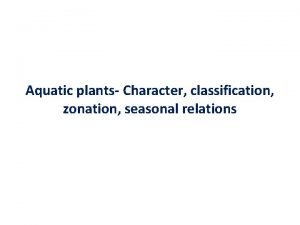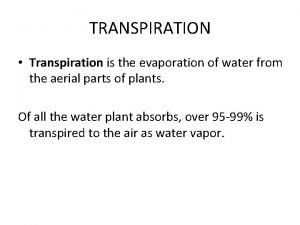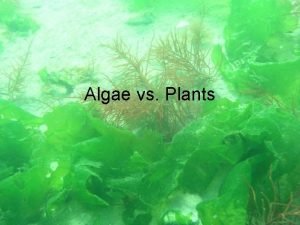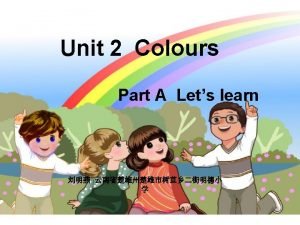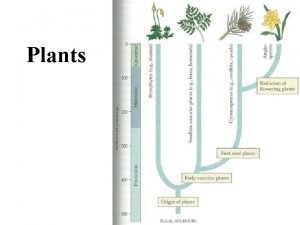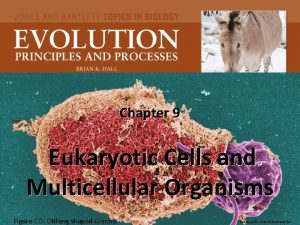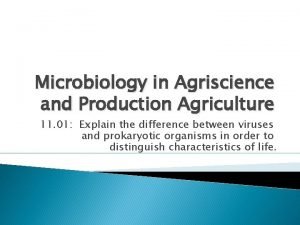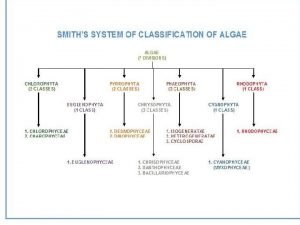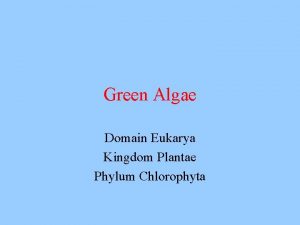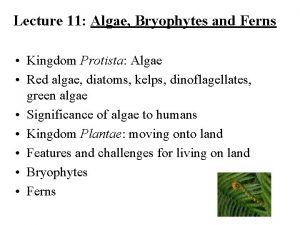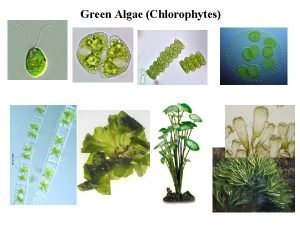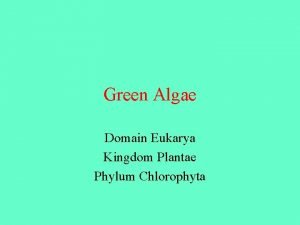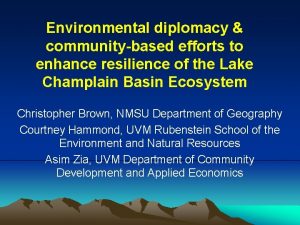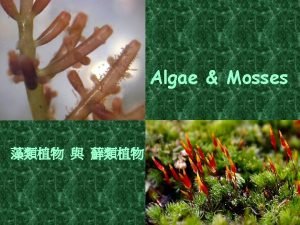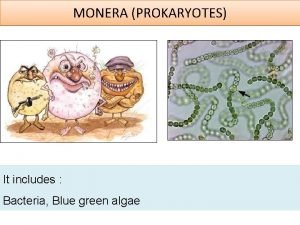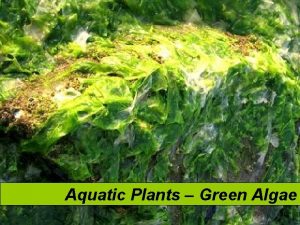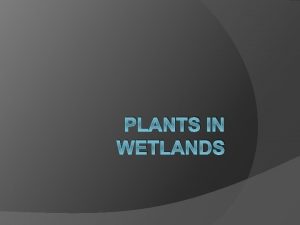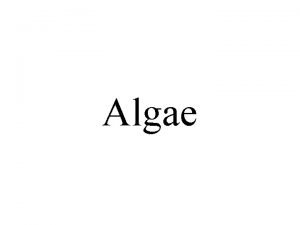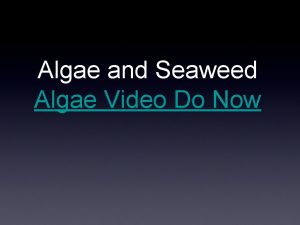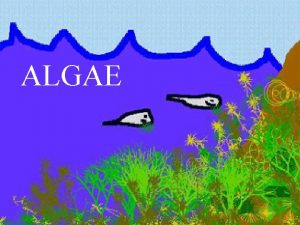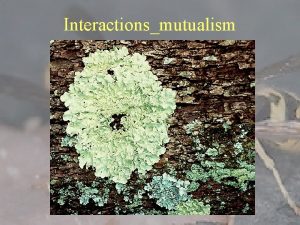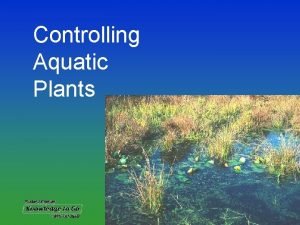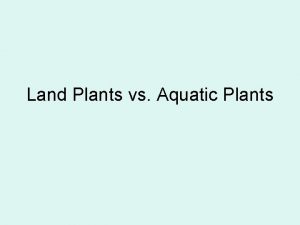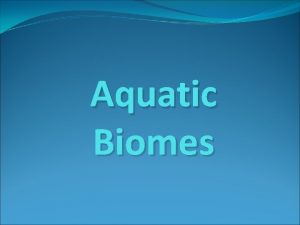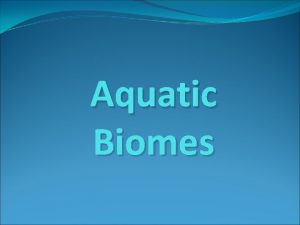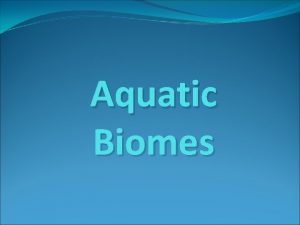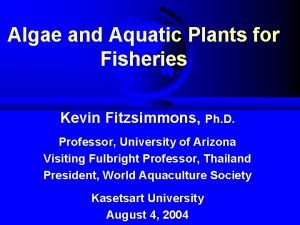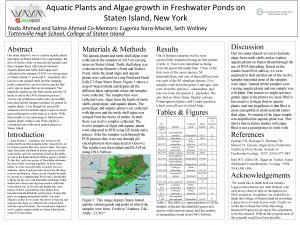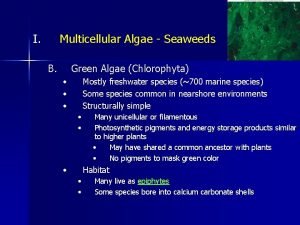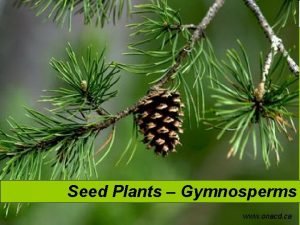Aquatic Plants Green Algae www onacd ca Green





















- Slides: 21

Aquatic Plants – Green Algae www. onacd. ca

Green Algae There approximately 6000 species of green algae. Many live their lives as single cells while others form colonies or long filaments. Species of green algae can be aquatic (freshwater or marine) or terrestrial. Some green algae are even capable of forming symbiotic relationships with fungi to form lichens. Chlamydomonas Spirogyra Ulva

Characteristics of Green Algae • Most contain chloroplasts and nuclei (chlorophylls a & b give them the green color) • Have mitochondria with flat cristae • Some have flagella for movement • All have cell walls that contain cellulose • Some species can reproduce asexually by fission, fragmentation or zoospores (motile spores) • Most species can reproduce sexually using a method called “alternation of generations” where they go through 2 different life stages

Alternation of Generations What is it? A life cycle in which there are two distinct life stages that occur alternately for a species Stage 1 (the sporophyte generation) • Diploid (2 N – each cell has two sets of chromosomes) • Produces haploid spores by meiosis and is thus called a sporophyte Stage 2 (the gametophyte generation) • Haploid (1 N – each cell has one set of chromosomes) • Produces gametes (sex cells) by mitosis and is thus called the gametophyte Gametes then fuse to form a diploid zygote which grows into a new sporophyte


Let’s take a closer look at some different types of examples of members of the Green Algae

Chlamydomonas Characteristics • Unicellular • Motile, 2 equal flagella • Occur in stagnant water and damp soil, fresh water and salt water; even in snow! • Have a nucleus inside their chloroplast • Possess two small vacuoles which function to remove waste • Have a light sensitive, red pigment spot which allows the cells to swim towards light (this is called positive phototropism)

Chlamydomonas Life Cycle Take a good look at the diagram below of the life cycle of Chamydomonas which is an example of an alternation of generations. Try to identify the diploid (2 N) and the haploid (1 N) stages of its life. Diploid (2 N)

Spirogyra • Algal cells are joined end to form filaments (multicellular) • Mostly freshwater • Generally free floating • Reproduces asexually by fragmentation and sexually by conjugation • Does not form gametes, therefore does not go through alternation of generations Above: Spirogyra filaments undergoing conjugation What is conjugation? It is merely the transfer or exchange of genetic information from a donor cell to a recipient

Ulva (sea lettuce) • Multicellular green algae (looks like a plant) • Lives in marine and brackish water • Has flat, blade like leaves called a thallus which is made up of two layers of cells • Undergoes alternation of generations to reproduce • Gametes are freeswimming and a zygote is formed in the water

Ulva Life Cycle MITOSIS Can you label in the diagram where mitosis would be taking place?

Lichens • Can be formed by a symbiotic relationship between a green algae and a fungus • The fungus provides the algae with water and minerals that it absorbs from whatever it is growing on, and also protects the algae by retaining water and serving as a larger capture area for minerals and nutrients

• The algal cells use minerals and water to make food (by photosynthesis!) for the fungus and itself • The fungus surrounds the algal cells and one cannot live without the other Above: Cross-section through the lichen Pseudevernia furfuracea with plainly visible layer of green algae under the surface

5 Really Bad Algae Jokes…. . Why did the algae and the fungus get married? They took a lichen to each other. Why do many algae couples drift apart? They prefer planktonic relationships. Why couldn't the algae keep a girlfriend? He wasn't a fungi. Why did the algae get pulled over on his way to the pond? He was chloro-plastered. Why did the algae fail math? He divided when multiplying.

Algae • Naming – Rhodophyta = Red Algae – Chlorophyta = Green Algae – Phaeophyta = Brown Algae

Characteristics of Algae – They are built up of multiple cells – They have organelles – They use the photosynthesis reaction to obtain energy in the form of sugar (glucose) – Some are motile and contain flagella

Red Algae – Found mostly in salt water – Color pigments • Chlorophyll “a” and sometimes “d” • Carotenes • Soluble phycobilins – Red pigment phycoerythrin – Blue pigment phycocyanin

Red Algae • They grow at depths of 175 meters (574. 14 feet i. e. 109 times my height) • They are red as only blue light can make it to these depths. The color of light something absorbs is different than the color we perceive. • White reflects all colors and Black absorbs all colors.

Green Algae – Color pigments • Both chlorophyll “a” and “b” • “b” makes it more like a terrestrial plant and therefore is most successful in using photosynthesis. – Habitats • Most commonly in freshwater • They are also found in salt water and other moist environments • Terrestrial

Brown Algae – They are the largest algae in terms of size. – Color pigments • Chlorophyll “a” and sometimes “c” • Fucoxanthin – Algin, which is produced by brown algae, has many functions in society • • Puddings, pie and cake fillings Candy Toothpaste Hand lotion

Brown Algae • Larger forms contain airbladders used for floatation • They can grow up to 100 m long. • An obvious example from BC is bull kelp • When scuba diving this kelp is awesome to observe at depth, but problematic to swim through as it can get tangled on your scuba tank.
 Aquatic plants can be classified into
Aquatic plants can be classified into Anatomical adaptation of hydrophytes diagram
Anatomical adaptation of hydrophytes diagram Stomatal transpiration diagram
Stomatal transpiration diagram Is protista unicellular or multicellular
Is protista unicellular or multicellular Protists vs plants
Protists vs plants Red green show
Red green show Kobe kuiz
Kobe kuiz Green algae supergroup
Green algae supergroup Is green algae prokaryotic or eukaryotic
Is green algae prokaryotic or eukaryotic What domain is algae in
What domain is algae in Blue green algae monera
Blue green algae monera Chlorophyta kingdom
Chlorophyta kingdom Importance of algae
Importance of algae Ferns and algae kingdom
Ferns and algae kingdom Life cycle of ulva
Life cycle of ulva Zygnema phylum
Zygnema phylum Blue green algae bloom
Blue green algae bloom Green algae cell structure
Green algae cell structure Alveolata characteristics
Alveolata characteristics What domain is green algae in
What domain is green algae in Application
Application Nonvascular plants
Nonvascular plants
